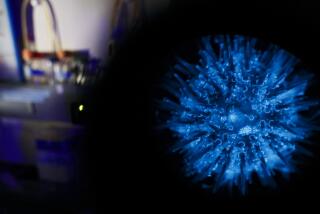Octopus studies detail strange behavior and genetics
UC Berkeley marine biologist Roy Caldwell first saw the intriguing octopus in Panama, in 1977. It was pretty, and striped, and about the size of his little finger. He brought a few specimens back to his lab, and one of the females surprised him: Unlike most octopuses he had seen, she didn’t die after laying her eggs -- she kept eating, and then laid more eggs.
“If I had known more, I would have written about it,” he said of the animal’s behavior.
Instead, Caldwell wound up waiting more than 30 years to see more of the mysterious little octopus, known as Octopus chierchiae, and longer still to study their even more elusive larger cousins, which have been seen so infrequently that they never been given a scientific name, and are known simply as larger Pacific striped octopus, or LPSO.
LPSO, approximately tennis-ball-sized, had been reported to have engaged in unusual behaviors for an octopus, including living in large colonies and living in dens as pairs after mating -- but behavioralists studying marine animals hadn’t had much opportunity to confirm the early research.
That changed when Caldwell and colleagues were able to get access to LPSO through the aquarium trade, and brought them to a laboratory for observation between 2012 and 2014. On Wednesday, the scientists published a paper in the journal PLOS One that reported what they found -- and it was just as interesting and unusual as the early brushes with LPSO had hinted it would be. As had been observed before, the LPSO mated beak-to-beak, shared dens, lived in groups and were able to spawn for extended periods.
Caldwell said he was especially impressed with the LPSO’s hunting technique, which he compared to a tiger’s stalk and pounce. The octopus identifies its prey, darkens and compresses its body before extending one arm over, say, a shrimp -- a fist-like ball of suckers rolled up at its end. Then it pokes the shrimp, causing the shrimp’s tail to flinch, which draws the prey back into the arms of the LPSO.
“It’s fairly dramatic,” he said. “It’s an animal that’s responsive in ways other octopus aren’t. I’ve never seen another species do this.”
Caldwell said that the new study was a vindication of sorts for coauthor Arcadio Rodaniche, who made some of the first observations of LPSO a quarter of a century ago.
Octopus fans also had more to cheer about Wednesday, with the release of another octopus-related study in the journal Nature: a work detailing the complete genome of Octopus bimaculoides, also known as the California two-spot octopus.
That study aimed to answer a number of questions about octopus genetics including how the animal’s unusual biology and behaviors are reflected in its DNA, said study lead author Daniel Rokhsar of UC Berkeley and the Okinawa Institute of Science and Technology in Japan.
Among marine animals, octopuses “are unusual because they exhibit complex behaviors,” he said. “They sense their environment.”
So the team, which included researchers from the University of Chicago, hoped to see if octopus DNA would display differences from other marine invertebrate DNA that might explain its large brain and unusual shape, among other traits.
Looking closely at the animal’s complete catalog of DNA -- nearly as long in length as the human genome -- the team studied genes associated with neurological development and with body plan, and also identified many previously unknown genes related to skin coloration and camouflage.
Moving forward, said University of Chicago neurobiologist Clifton Ragsdale, the octopus genome should help biologists learn more about all kinds of mollusks.
“The octopus genome makes studies of cephalopod traits much more tractable, and now represents an important point on the tree of life for comparative evolutionary studies,” he said in a statement. “It is an incredible resource that opens up new questions that could not have been asked before about these remarkable animals.”
Caldwell, the lead author of the study of the LPSOs, played a small role in the Nature study as well. He supplied the octopus that was sequenced.
For more on science and health, follow me on Twitter: @LATerynbrown







